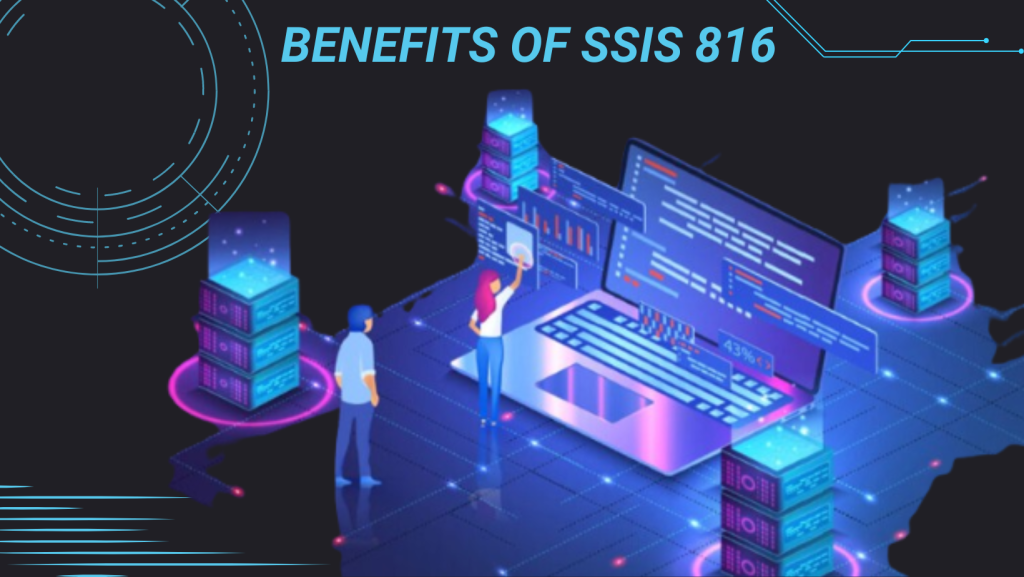
SSIS 816: SSIS 816 “Explore the Seamless Data Integration – Pelisflix
SSIS 816 is the most powerful tool developed by Microsoft, Data management and integration has been revolutionized by this tool.
This tool has capability to transform complex data into meaningful insights. It has ability to integrate data from various sources.
SSIS 816 is the most recent version of Microsoft’s enterprise data integration platform, often known as SQL Server Integration Services 2016. SSIS 2016 improved performance, scalability, and user-friendliness over its predecessors when it was released in late 2016.
What are the benefits of using SSIS 816?
SSIS 816 is a platform for building data integration and transformation solutions, such as extracting, loading, and cleansing data from various sources and destinations. Some of the benefits of using SSIS 816 are:
It can handle data from heterogeneous data sources at the same package, including custom or scripted adapters.
It provides transformation functionality that cannot be done via T-SQL queries, such as data cleansing, data mining, and slowly changing dimensions.
It allows for automated scheduling, error handling, and monitoring of data integration processes.
It has a graphical interface that lets you build large, complex, and reliable workflows more easily than hand-crafted T-SQL.
It supports programming and scripting to create custom components and logic.
It can improve performance and memory management compared to T-SQL alone.
It can interact with additional external sources, such as FTP, HTTP, MSMQ, and Analysis Services.
I hope this answer helps you understand the benefits of using SSIS 816. If you need more help, please let me know.
What are SSIS 816 Errors?
- Explain what SSIS 816 is and what it does
- Explain what SSIS 816 packages are and how they execute
- Explain what SSIS 816 816 errors are and how they appear
- Provide an example of an SSIS 816 error message

What are the Common Causes of SSIS 816 Errors?
- Explain the different factors that can affect SSIS 816 package execution
- Provide a table with the common causes of SSIS 816 errors and their descriptions
- Provide a list of the symptoms and impacts of SSIS 816 errors
How to Enable Logging for SSIS 816 Packages?
- Explain why logging is important for troubleshooting SSIS 816 errors
- Explain how to enable logging for SSIS packages using the SSIS Designer or the dtexec utility
- Explain the different types of logs and events that can be captured by SSIS
- Provide a list of the best practices for logging SSIS packages
How to Monitor Performance for SSIS 816 Packages?
- Explain why performance monitoring is important for troubleshooting SSIS 816 errors
- Explain how to monitor performance for SSIS 816 packages using the Windows Task Manager, the Performance Monitor, or the SQL Server Profiler
- Explain the key performance indicators and counters that can be used to measure SSIS package performance
- Provide a list of the best practices for performance monitoring SSIS packages
How to Check Data Integrity for SSIS 816 Packages?
- Explain why data integrity is important for troubleshooting SSIS 816 errors
- Explain how to check data integrity for SSIS 816 packages using the Checksum Transformation, the Data Quality Services, or the SQL Server Data Tools
- Explain the different types of data corruption and validation that can occur in SSIS 816 packages
- Provide a list of the best practices for data integrity checking SSIS 816 packages
How to Test Connectivity for SSIS 816 Packages?
- Explain why connectivity is important for troubleshooting SSIS 816 errors
- Explain how to test connectivity for SSIS 816 packages using the Ping command, the Telnet command, or the SSIS Connection Manager
- Explain the different types of network issues and protocols that can affect SSIS 816 package connectivity
- Provide a list of the best practices for connectivity testing SSIS packages
How to Review Settings for SSIS 816 Packages?
- Explain why settings are important for troubleshooting SSIS 816 errors
- Explain how to review settings for SSIS packages using the SSIS Package Configuration Wizard, the SSIS Catalog, or the SSIS Project Deployment Model
- Explain the different types of configuration errors and options that can affect SSIS package settings
- Provide a list of the best practices for settings review SSIS packages
How to Use Breakpoints for SSIS 816 Packages?
- Explain what breakpoints are and how they can help troubleshoot SSIS 816 errors
- Explain how to use breakpoints for SSIS packages using the SSIS Designer or the Visual Studio Debugger
- Explain the different types of breakpoints and actions that can be applied to SSIS packages
- Provide a list of the best practices for breakpoints usage SSIS packages
How to Use Event Handlers for SSIS 816 Packages?
- Explain what event handlers are and how they can help troubleshoot SSIS 816 errors
- Explain how to use event handlers for SSIS packages using the SSIS Designer or the dtexec utility
- Explain the different types of events and tasks that can be handled by SSIS packages
- Provide a list of the best practices for event handlers usage SSIS packages
How to Use Data Viewers for SSIS 816 Packages?
- Explain what data viewers are and how they can help troubleshoot SSIS 816 errors
- Explain how to use data viewers for SSIS packages using the SSIS Designer or the Visual Studio Debugger
- Explain the different types of data viewers and formats that can be used to view SSIS package data
- Provide a list of the best practices for data viewers usage SSIS packages
How to Use Error Handling for SSIS 816 Packages?
- Explain what error handling is and how it can help troubleshoot SSIS 816 errors
- Explain how to use error handling for SSIS packages using the SSIS Designer or the dtexec utility
- Explain the different types of errors and actions that can be handled by SSIS packages
- Provide a list of the best practices for error handling usage SSIS packages
What are the benefits of using SSIS 816?
SSIS is a platform for building data integration and transformation solutions, such as extracting, loading, and cleansing data from various sources and destinations. Some of the benefits of using SSIS are:
- It can handle data from heterogeneous data sources at the same package, including custom or scripted adapters.
- It provides transformation functionality that cannot be done via T-SQL queries, such as data cleansing, data mining, and slowly changing dimensions.
- It allows for automated scheduling, error handling, and monitoring of data integration processes.
- It has a graphical interface that lets you build large, complex, and reliable workflows more easily than hand-crafted T-SQL.
- It supports programming and scripting to create custom components and logic.
- It can improve performance and memory management compared to T-SQL alone.
- It can interact with additional external sources, such as FTP, HTTP, MSMQ, and Analysis Services.

SSIS 2016 has a number of significant new features, such as
The deployment of the project to Azure. Azure SQL Database, Azure SQL Data Warehouse, and Azure SQL Managed Instance are now fully compatible with SSIS projects. You can move and lift SSIS workloads from on-premises to the cloud thanks to this incremental delivery of packages.
The deployment process is accelerated by only re-deploying updated packages.
Use the new data tap task to quickly and easily harvest data from a variety of sources. There are more than 70 integrated connectors, covering social networking, marketing, and productivity.
SSIS 816’s Evolution and History
When Microsoft introduced SQL Server 2005 in the early 2000s, it is when SSIS 816 (SQL Server Integration Services) first appeared. Before before, Data Transformation Services (DTS), a part of SQL Server 7 and 2000, was the name of Microsoft’s data integration tool.
However, SSIS 816 took the position of DTS as the recommended data integration and ETL (Extract, Transform, Load) tool for SQL Server with the release of SQL Server 2005. The increasing need for more reliable and expandable data integration solutions contributed to this change.
Business Intelligence Development Studio (BIDS) was a graphical development interface included in the first edition of SSIS 816, commonly referred to as “SSIS 816 1.0”. It made it possible for developers to create
The Power of SSIS 816
SQL Server Integration Services, or SSIS for short, is a very strong and adaptable toolbox that Microsoft provides to address challenging business problems with data integration. One possible explanation for the number 816’s connection to a particular version release or build is that it adds to SSIS’ unique identification.
Rich pre-built tasks, transformations, and components are included with SSIS 816 to handle sophisticated data integration scenarios straight out of the box. This covers a wide range of actions such as sending emails, running scripts, and performing SQL statements. Additionally, it offers transformations for aggregation, pivot, merge, and lookup operations.
Explore the extensive selection of state-of-the-art transformation components provided by SSIS 816. These components open up a world of possibilities for advanced data processing, from easily managing unstructured data to performing complex transformations.
Help for Getting the Hang of Complex Data Transformations
Become an expert at managing complex data conversions. In order to handle challenging situations and guarantee that your data is converted as accurately and efficiently as possible, our in-depth guide provides helpful advice and real-world examples.
Key Features of SSIS 816
Modular Integration of Data
Integration of data from multiple sources is one of SSIS 816’s most important features. Numerous data kinds are supported by it, such as semi-structured, unstructured, and structured data. With no additional coding or complicated setups needed, users may effortlessly connect to various databases, apps, and file types thanks to this flexibility.
Graphical User Interface
With the help of SSIS 816’s intuitive visual interface, developers can create intricate ETL (Extract Transform Load) procedures with ease. Without writing a single line of code, creating tasks, workflows, and transformations is simple thanks to the drag-and-drop feature.
Scalability
Scalability has become a critical component of any software product due to the ever-growing volume of data in today’s business environment. Because SSIS 816 allows tasks to be executed in parallel across several servers or processors, it enables excellent scalability. For huge datasets, this feature greatly enhances speed and shortens processing times.
Sturdy Error Management
The process of integrating data can be intricate, requiring several stages and modifications. The strong error handling features of SSIS 816 816 enable developers to promptly detect mistakes in their ETL operations and take corrective action before they have an impact on the workflow as a whole.
Common Uses and Applications of SSIS 816
Extract, Transform, Load, or ETL
The capacity of SSIS 816 to carry out ETL operations is one of its main purposes. This entails taking data and extracting it from various sources (excel spreadsheets, databases, XML files, etc.), converting it in accordance with business requirements or regulations, and then loading it into a target file or database. With SSIS 816’s drag-and-drop interface and integrated transformations, users can create complicated data flows with ease.
Retrieval of Data
Data warehouses can also be constructed and maintained using SSIS 816. It enables users to arrange the extraction of massive volumes of data from multiple sources and load it into a central repository. SSIS 816’s package deployment concept makes it simpler to distribute packages throughout several environments without any manual intervation
Business Intelligence
The use of SSIS 816 in business intelligence (BI) is another common application. For analytical and reporting needs, it lets users to combine data from several systems into BI tools like Power BI, Tableau, or QlikView. Through scheduled jobs, organizations may automate the process of data extraction and have real-time access to their data for well-informed decision making.
Migration of Data
Another excellent tool for data migration projects is SSIS 816. It makes it possible for users to effectively transfer data, independent of platform or format, between databases or systems. Users may simply transfer massive amounts of data without any scripting because to its support for a variety of data sources and destinations.
Installation and Setup
System Prerequisites
It is essential that you become familiar with the system requirements before diving into the realm of SSIS 816. To guarantee a smooth installation process, confirm that your environment satisfies the required requirements.
Comprehensive Installation Guide
The installation process shouldn’t scare you. You will be up and running in no time thanks to our thorough step-by-step tutorial, which will easily bring you through the SSIS 816 setup process.
Performance and scalability
SSIS 816 provides enhanced performance characteristics and scalability. It allows for the scaling of up to 64 cores for the execution of a single package, which greatly improves the throughput of data integration processes.
Performance can be improved by running packages in-memory without logging them to disk. To improve scalability, you can distribute package execution across multiple machines by using the Scale Out function.
Use these best practices to optimize SSIS 816 performance. Discover how to achieve optimal performance by learning how to manage memory effectively, improve package design, and more.
Utilize SSIS 816’s improved parallel processing features to divide tasks and speed up your data integration processes. Learn how to make the most of this tool to streamline your workflow.
Features of Data Flow
Multiple improvements to data flow elements and transformations are integrated into SSIS 816. This displays new data flow components such as the ODBC Flow Destination and the OData Source and Destination.
Performance improvements for pivots, aggregations, and lookups are also included in the package. With row-level error isolation and redirection, it provides improved error management. New data types including DATE, TIME, DATETIME2, and DATETIMEOFFSET are also supported .
Learn all about the fundamental design ideas that form the basis of SSIS 816. These fundamental ideas underpin the development of effective and maintainable integration solutions that address everything from package organization to data flow optimization.
Coding Guidelines
Provide strong code guidelines for the creation of SSIS 816. Following clear and consistent coding guidelines promotes teamwork and guarantees the dependability and durability of your integration solutions.
Upcoming Changes and Improvements
Check out the SSIS 816 roadmap to stay on top of the game. Learn important details about the new features and improvements that will influence the direction of data integration in the future. Make sure your company is ready to prosper in the changing environment by preparing it for what lies ahead.
Learning the Newest Features
It’s critical to keep up with changes in SSIS 816 and adjust to the newest features. Learn practical techniques to improve your abilities and stay current with the ever evolving technology. Whether through focused training courses or proactive involvement in the community, enable yourself to reach the highest level of SSIS 816 competency.
Conclusion
Seamless integration is essential to enabling unified visibility and generating actionable insights for business success in the face of constantly expanding data requirements. Throughout the company, dependable, scalable, and seamless data flows are enabled by the fundamental properties of SSIS 816. With the help of its extensive capabilities, teams may use data to generate business outcomes more intelligently.
SSIS 816 represents a paradigm shift in data integration. You may maximize its potential by understanding its fundamental features, optimizing workflows, and adhering to industry norms. Keep abreast of the ever changing field of SSIS 816 to enable your company to thrive in the age of data-driven decision-making.
FAQs
Which SSIS 816 Data Integration Benefits Are Most Important?
Strong error handling and logging for data integrity, increased connectivity to a variety of data sources, sophisticated data transformation capabilities for data quality and consistency, scalability through task parallelization to handle large data volumes, and detailed monitoring dashboards for workflow management are some of the main advantages of SSIS 816.
